One Good Thing
The Washington Post is offering free subscriptions for students, military, and government employees
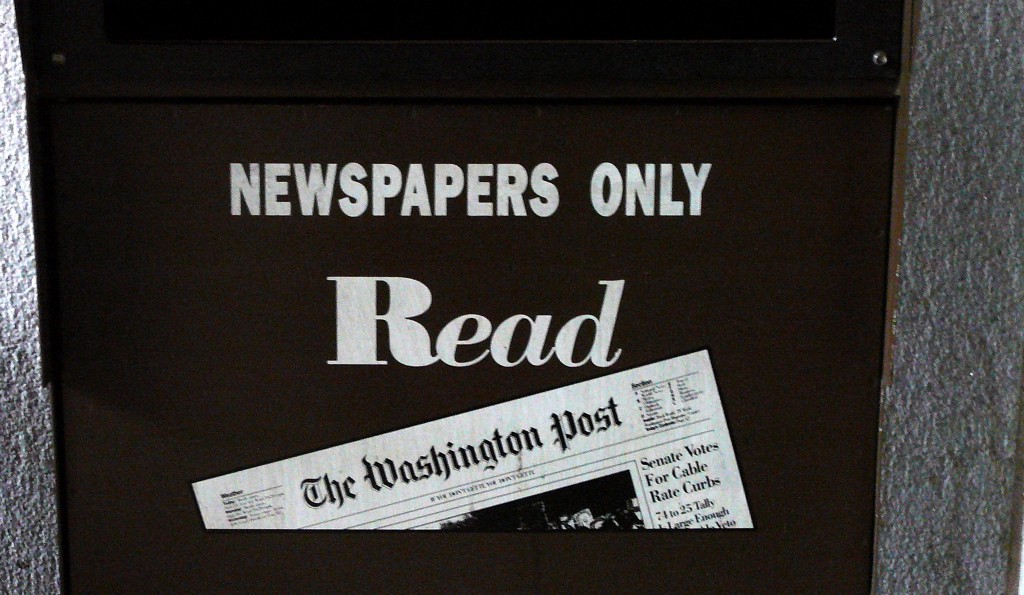
For almost a week now, “What can we do?” has been the general chorus in all of my feeds. “Here is what I have done, how can I do more?” is popular. “Wanna help? Here is what I need from you,” is too*. Generally speaking, people seem inclined to do something actionable, but are either doubtful that donating their money is enough (true!), or concerned that their white/het/cis/otherwise privileged friends aren’t really grasping their perspective.
At the same time that this is happening, there’s been a fair amount of discussion in the media about whether or not Facebook’s algorithm contributed to a proliferation of misinformation that ended up skewing the 2016 election. More simply, if your platform allows Macedonian teens to fabricate fake, buzzy stories and mass distribute them with no system for alerting readers that, “This Facebook page might not be true at all,” are you… culpable? Or just chaotic neutral? (Chaotic neutral is still culpable imo.) Still more people are focused on the idea of a “news bubble” that only serves you content aligned with your own sensibilities, which means we’re all effectively locked in our own fart chambers all day, sitting around smelling our own farts online.
Is any of this gonna prove 100% causality? Of course not. Wanna hear something nice, though? No matter who we’re horny to blame for our great national nightmare today, the Washington Post is offering a solution that attempts to address a lot of those concerns: free digital subscriptions for anyone with a .edu, .mil, or .gov email address. It’s like a company asked itself, “What can we do?” and then did it. Rare.
All students, military personnel, and government workers now have full access to the 138-year-old D.C.-based newspaper, and it boasts all of the piping-hot features you crave from your news: reporting, data from reputable sources, analysis. All you have to do to activate is register your email address on their site, and then maybe like them on Facebook too so the articles start appearing in your feed day-to-day.
This reads like some kind of paid ad but it’s not. I just like it when people are ethical and good, and this feels like a newspaper being ethical and good in a time when print media is… not doing so hot. Good for them. And get that free content if you can.
_____
*These posts are the best posts and thank you if you have written one.
Riohv, "Sun Shadow"
It was a great weekend to be away from the Internet.

If you were on social media this weekend I’m sorry, and I hope whoever is holding your family hostage and threatening to hurt them unless you look at Facebook lets them go soon, because I can’t imagine any other reason you would be on social media this weekend. If you were smart enough to avoid it, here’s what you missed: Everyone is terrible, even the good people, and there aren’t any good people anymore. Everybody knows for sure what happened in the election and how things would have been different if their preferred alternative had occurred and what we need to do next to fix everything and how whatever you have decided to do next is not only wrong but a deliberate insult to the people who are really suffering, a group of which you are certainly not a member. It is a lot like Yeats’ “Second Coming” except even those who lack all conviction are issuing numbered threads about how their conviction is lacking, which other people are simply retweeting with the word “Thread.” I get that we live in a world where the maxim is now “Why think something unless you’re going to say it?” but is it too much to ask that you press pause for a week on the saying part and then maybe reflect on whether or not those thoughts really need to be shared? Hahaha, just kidding, I know your thoughts need to be shared. Otherwise how will people know how right you are and, more importantly, how incorrect everyone else is?
Anyway, here’s music. Enjoy.
Two Divorce Lawyers Watch "Divorce": Ep. 5
What the show gets right and wrong about divorce in New York
by Marcy Katz and Tom Kretchmar

The fifth episode of “Divorce” picks up where episode four left off: in the rec room-chic home office of a local trust and estates lawyer named Gerald Watkins Mayfield, who pitches his ability to handle Robert’s divorce with the nonsensical faux-maxim “basically, it’s all law.” Robert’s discomfort with Mayfield’s credentials is palpable but he agrees to hire him anyway, at least in part due to Mayfield’s assurances that he’s more inexpensive than Manhattan counsel. At the close of their meeting Mayfield consults his wife’s kitchen timer — which serves double duty as his billing clock — and tells Robert that he owes him for one hour’s worth of work, preferably in cash.
This was surprising: it’s clearly a consultation, and generally speaking, divorce lawyers charge a flat rate for those, regardless of how long it lasts. A consultation is an essential step in retaining a divorce lawyer: after passing the lawyer’s conflict check, a potential client will visit the lawyer to talk about what’s been going on before formally retaining the lawyer. The “conflict check” is an internal process where the lawyer confirms that the potential client’s spouse has never met with their firm before. If they have, it would present a conflict of interest barred by various ethics rules, and it would prevent the attorney and the prospective client from meeting or discussing the case any further.
Mayfield also should have presented Robert with a “statement of client’s rights and responsibilities.” New York law requires divorce attorneys to provide this document to all potential clients; it’s a recitation of various protections that a client is entitled to with respect to billing and case management. Although it exists to protect the potential client, it catches some people off guard. Understandably, some people worry that they’re being asked to sign some type of contract before they’ve even really spoken with the lawyer. That’s not what’s going on; it’s not a contract. The signature line is merely an acknowledgement confirming that “yes, I was given this piece of paper telling me that I have certain special protections.”
After the consultation, if the client chooses to hire (“retain”) the lawyer, a retainer agreement will be prepared and executed. This is the actual contract that sets forth the nature of the relationship and the details of the fee arrangement. After Robert hires him, Mayfield gets to work right away, disastrously: he tries calling Robert later that night and accidentally dials the Dufresne’s home line, thereby revealing to Frances, by way of caller I.D. and a bumbling series of lies, that Robert has abandoned mediation and retained counsel.
Frances wastes no time setting up a consult with high-powered Manhattan counsel: Max Brodkin, a matrimonial specialist with all the experience, resources and success that Mayfield lacks. Although Brodkin dishes up some platitudes of his own (“With me, you get a partner; we walk through this together… your problems are my problems”), we admired the preliminary integrity we perceived in his conversation with Frances. Brodkin encourages Frances to take pen to paper, on her own time, writing out the stream of consciousness details that she’s started to ramble about during the consult meeting. Although an uninformed cynic might argue that Brodkin was just rushing Frances through the consultation meeting (since, in all likelihood, their consultation meeting was a flat rate rather than on the clock) we don’t think that’s what was happening at all.
Instead, Brodkin was engaging in some excellent and routine client management, for Frances’s benefit: all too often, matrimonial law clients will spend surprisingly substantial amounts of time talking to their attorneys about issues that are not particularly relevant to the divorce action, racking up hundreds (and cumulatively thousands) of dollars in fees that could have been avoided if the client had found a more efficient and concise way of presenting and refining those issues and anecdotes. Brodkin realizes that Frances has a lot that she wants to talk about (such as her refusal to ever fake an orgasm) and that she has no real sense, yet, of what’s relevant and not. He knows that everyone will be better off if he can get her to organize her thoughts on her own time, off his clock, rather than wading through them in his office, brainstorm-style. This is an essential part of a successful relationship between a divorce lawyer and client: efficient use of everyone’s time.
Over dinner with his friend Nick, Robert learns that Frances has retained Brodkin, and that that Mayfield is no match for Brodkin’s talents. Robert, already furious about the phone call slip-up, promptly fires Mayfield after dinner. Robert upgrades his counsel that same evening, in a late night meeting in Manhattan, with a farcical shark of an attorney named Tony Silvercreek — a man described later, by Francis’s friend Dallas, as “one of the most ruthless, disgusting, go-for-blood lawyers in divorce.”
During their midnight meeting, Silvercreek talks a nasty game, ostentatiously drinks decanted whiskey, and bullies Robert into retaining him. Immediately afterwards, Silvercreek calls Frances on her cell phone to introduce himself and antagonize her. Although everything about Silvercreek’s character is ridiculous, this phone call was especially egregious. Since Silvercreek knows that Frances is represented by Brodkin (Robert would have surely told him this during the consultation meeting), his behavior directly violates Rule 4.2(a) of the New York Rules of Professional Conduct, which prohibits a lawyer from directly contacting an opposing client when that lawyer knows that he or she has a lawyer. Any lawyer who makes a phone call like Silvercreek’s can expect to have a disciplinary complaint filed in connection therewith immediately afterwards.
Unlike the Mayfield and Brodkin consultations, we don’t see Robert and Silvercreek discuss billing rates, or Robert’s ability to afford his services. Nonetheless, it’s likely that Silvercreek advised Robert of one of the most important rights a spouse with less financial wherewithal has under New York divorce law: the right to have a court force the other, more-monied spouse to contribute to the cost of the lesser-monied spouse’s legal fees.
Many people are shocked when they learn that this right exists, because it doesn’t seem to make intuitive sense that someone should have to fund the legal expenses of their adversary. However, as a matter of public policy New York State has adopted the position that in matrimonial litigation, the playing field should be leveled, so to speak, so that both spouses have a legitimate ability to prosecute their case. For this to happen, the lesser-monied spouse petitions the court for an official order. That same petition — which is actually called a “motion” or “order to show cause” in divorce lingo — frequently asks for other financial awards, such as temporary spousal support and temporary child support, if applicable.
Silvercreek already seems to be aware that Frances is the more-monied spouse (he observes, as we have in our previous commentaries, that Robert, rather than Frances, is likely to be the spousal support recipient in this case), so even if we didn’t witness it first-hand, it’s likely that Silvercreek has also advised Robert that he can expect to have Frances contribute towards the cost of his legal expenses in this action. Given that episode five also reveals that Frances has moved forward with the opening of her art gallery, she may end up in a pretty serious cash crunch long before the Dufresnes’ divorce is finalized or, for that matter, even meaningfully begun.
New York City, November 11, 2016

★★★★ The indirect glow off the buildings wrapped itself around the acorns fallen on the unyielding pavement. Sun filtered by the thinnest of cloud put a hard silvery gleam on passing faces. The grain of the clouds at different heights crisscrossed. The day was cool, bright, appropriate—the day doing the most it could possibly do with the limited and dwindling light.
An Even Closer Reading of Trader Joe's "Fearless Flyer"
Cranberrying all the way home
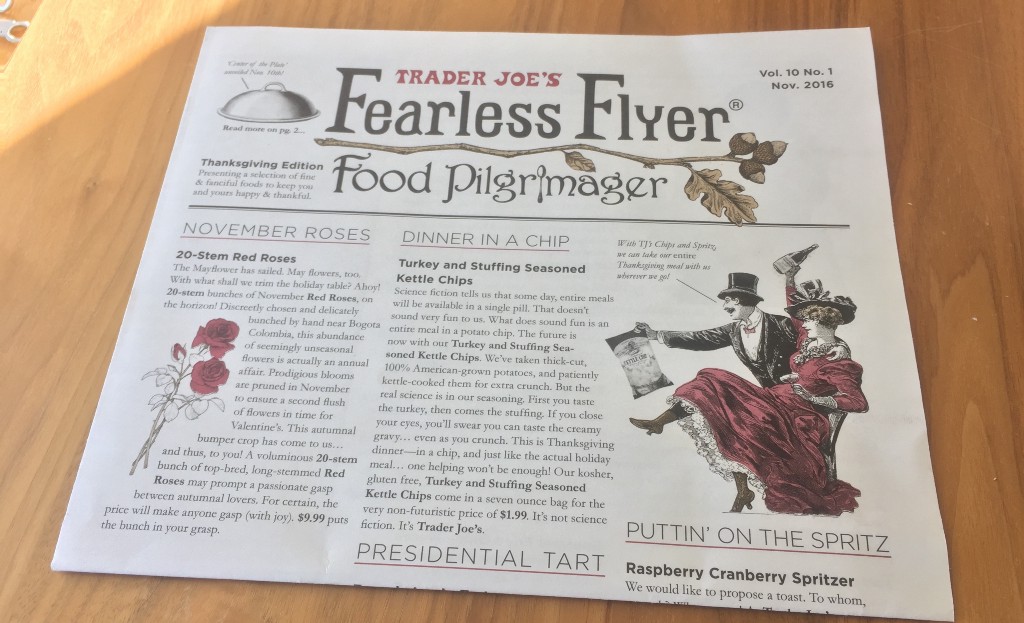
Where were you when your co-worker who knows you look forward to reading the Trader Joe’s monthly or bi-monthly (it’s unclear, tbh) newsletter told you about it? I was either in bed or on the floor, the only two places I have been able to work from this week:
balk [2:08 PM]
silvia there is a special thanksgiving issue of the fearless flyer
balk [2:12 PM]
it’s only 8 pp
balk [2:12 PM]
and it’s berliner format
balk [2:13 PM]
oh wait
the plot thickes
silvia [2:13 PM]
WHAT
balk [2:13 PM]
half the pages are half size
silvia [2:13 PM]
what
balk [2:13 PM]
it is one giant sheet
balk [2:13 PM]
folder into quarters
balk [2:13 PM]
and then pp 2–5 are actually the top of the whole sheet
so it’s like a big twee poster
they saved on color too, it’s only b/w and gradations of red
First, let’s get a few things straight. It is NOT Berliner format (also known as “midi,” measuring 12.4 by 18.5 inches), and Balk, bless his heart, is a print nerd. Depending on how you unfold it, the thing’s either 10.3 by 17 inches or 20.5 by 25.5 inches. Folded up entirely it’s about 8.5 x 10.75 inches, which is the only thing close to a recognizable print-nerd trim size. But it’s also not really 8 pp (print-nerd talk for “pages,” plural). Got that? It is one giant sheet, origami’d into eight “sections” designated as pages by black sans-serif numbers in red circles. The way the pages go is frankly confusing; the order is like this:
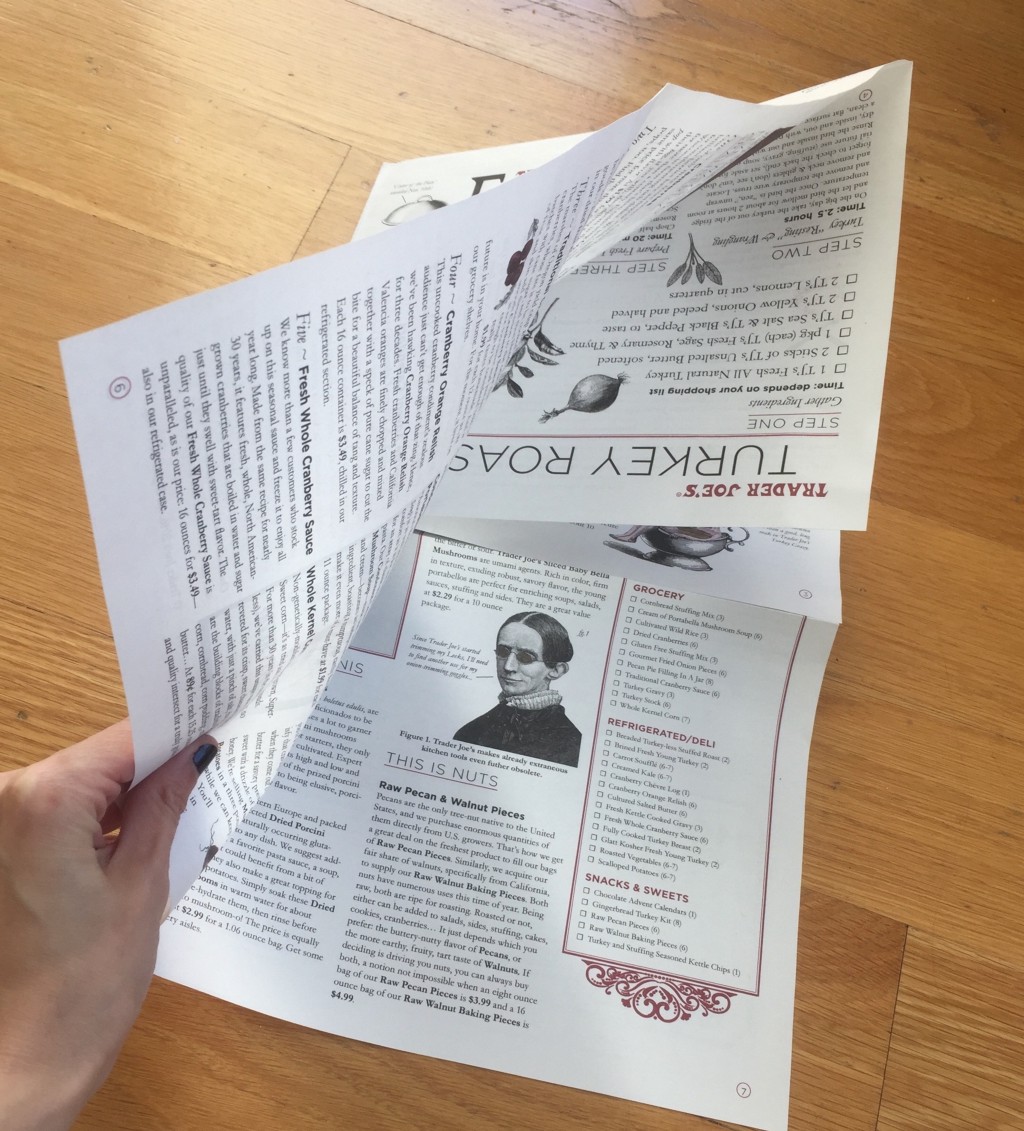
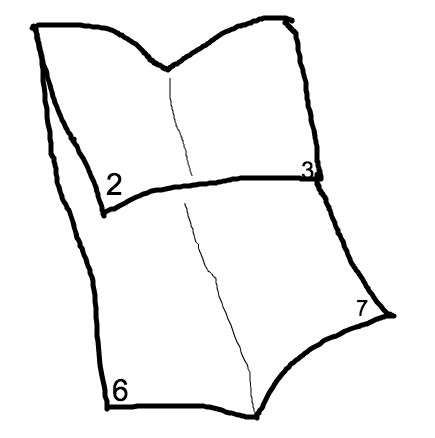
That drawing is not to scale but it should give you a good sense of how confusing this month’s “Fearless Flyer” is. You’ll just have to infer where pages 1, 4, 5, and 8 are from that drawing, because frankly I didn’t feel like spending that much time on sumopaint.com, but I think you get it. It’s confusing and unfolds sort of funny, almost like a regular newspaper, but worse. Imagine trying to read this on the subway!! No thank you. No wonder print is dead.
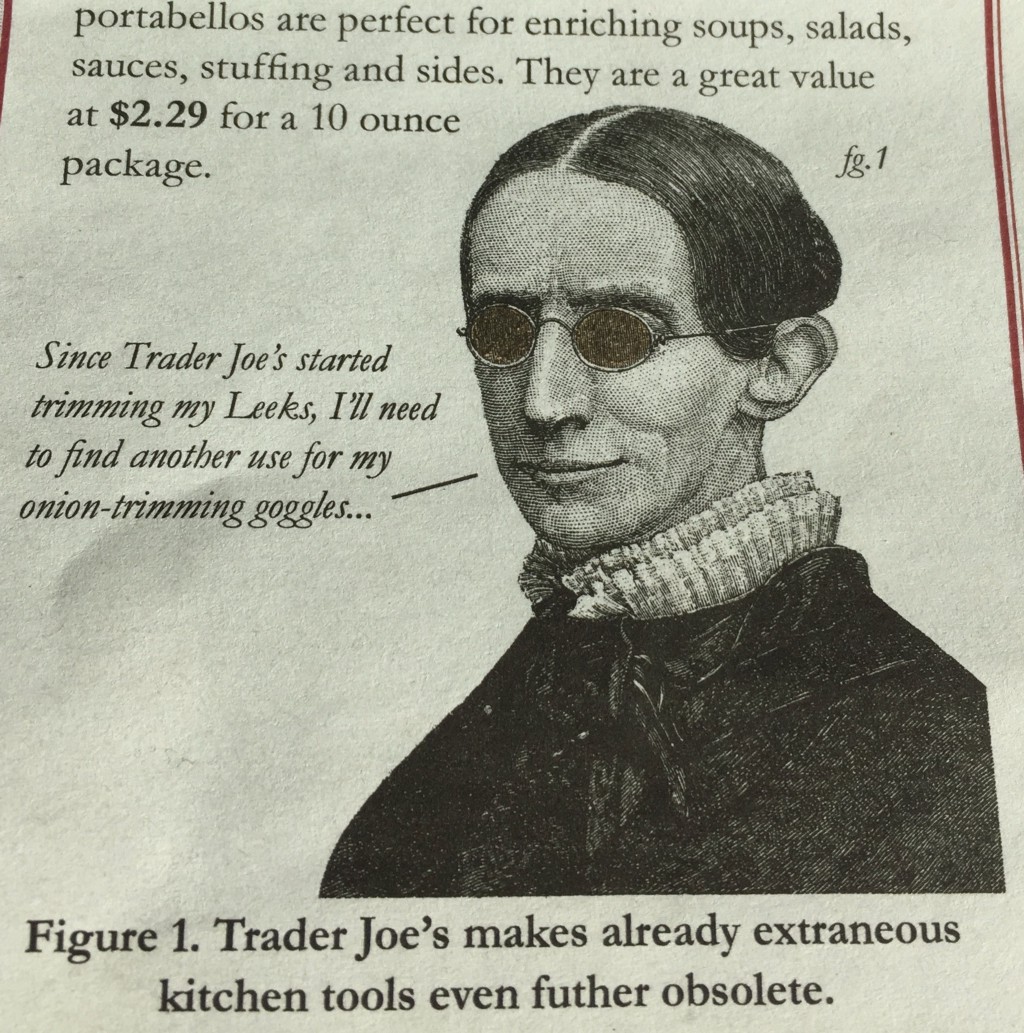
Moving on, let’s jump right into the content. This is indeed the Thanksgiving Edition of FF, and it is designed like a newspaper, sort of, with a header at the top, a little teaser about what’s inside where you might otherwise find the weather (cloudy with a chance of pumpkin). The first thing we encounter is a section titled “November Roses.” Don’t worry, seasonal monsters—winter roses are actually A Thing (but don’t try Googling “November Roses” because all you’ll get is Axl Rose’s weird epic). What is not a thing, however, is “20-Stem Red Roses.” A rose with twenty stems? The implied subject here of course is “bunch,” but now all I see is thorns. And anyway, why must you specify the number of stems? Is that not correlated to the number of blooms, possibly like directly, in a one-to-one relationship? The paragraph warns, “a voluminous 20-stem bunch of top-bred, long-stemmed Red Roses may prompt a passionate gasp between autumnal lovers.” Are they bred from the top? Nothing about these roses sounds romantic, also November is an awful time for romance. Give me a poinsettia and a dry peck on the cheek instead.
The next section is called “Dinner in a Chip” and begins, “Science fiction tells us that some day, entire meals will be available in a single pill.” I don’t know about you but I didn’t think Willy Wonka and the Chocolate Factory was really sci-fi but maybe that’s because I was more focused on the chocolate river. In any case, has Joe ever heard of soylent, or cricket bars? The paragraph goes on to say something about kettle-cooked potato chips that are flavored like turkey and stuffing but this is really missing the point because chips are only slightly less filling than a pill.
By this point I am starting to worry that the person who writes TJ’s “Fearless Flyer” has been living in a bunker since 1997 and is also just making most of this stuff up because there’s an entry for Raspberry Cranberry Spritzer, “Made with the juice of whole raspberries and cranberries (33 raspberries and 19 cranberries per bottle to be exact).” ????????????????????

First of all, did anyone else ever used to drink these things? Crystal Geyser Juice Squeeze? That’s what these are, and we’re in middle school now, and this is soda but no one knows it yet. Keep an eye on the cranberry though, it’s gonna show up a couple more times, I bet.
Sure enough, when you flip the page, or the top of the page, however you want to think bout it, you see a feature about “Five Ways to Cranberry.” Actually don’t worry about that just yet because it’s on page 6 and technically you’re supposed to keep the top flap folded down to read pages 2 and 3 (this makes no sense). Here you can find information about the various selections of turkeys, turkey breasts, and soy protein roasts you can purchase in time for The Big Food Holiday. But you can also find two particularly offensive word usages that I want to call out and make fun of.
First, isn’t it annoying when people use the word “task” as a verb? Yes, thank you, it is. “She was tasked with synthesizing the work products,” said one consultant to the other. “Our Organic Thanksgiving Herb Bouquets are up to the task,” claims Trader Joe’s. Okay, that’s acceptable. “And at $3.99 each, they won’t task your wallet.” -_- Thanks, but my wallet is busy eliminating redundancies.
The next one should theoretically please me but I assure you it does not. Under the header, “We’re On Your Sides”—ostensibly about meal sides, like mashed potatoes and rice and stuffing but sadly only reminiscent of my actual sides, the ones on my body just above my hips, where my hands are about to go—there is a section about Cornbread Stuffing Mix. I have no problem with this delicious and not-so-novel side dish. What I take issue with is the insistence on unnecessary wordplay in the following sentence: “By adding broth (or water) and butter, it instantly transforms into a fluffy, moist farce.*” Emphasis theirs, if you can believe it. Below this entry, the asterisk reads:
*“stuffing,” not “comic buffoonery.”
Ooooooookaaayyyyyyy. Sure. I mean, sure, yes, I know that the word comes from the literal French word for “stuffing,” farcir, and you know actually it is kind of interesting to draw the line from food-stuffing to theatrical stuffing by way of the phrase “forcemeat stuffing,” but frankly I would prefer to have this conversation out in the open air, and never ever committed to ink and paper with winky italics and explicative asterisks.
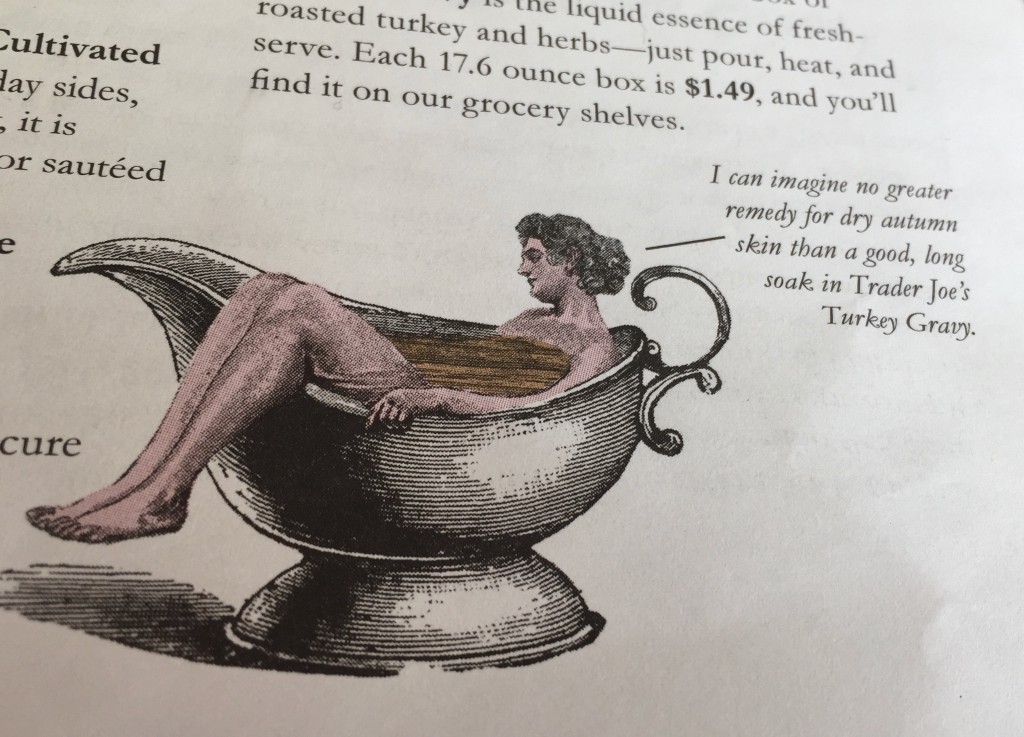
The last thing I want to address on the flap is a woman taking a soak in a gravy boat. Disgusting and unhygienic! Do you think I should try it? I mean as long as we’re putting snail goo on our faces, it couldn’t hurt right? Haha just kidding I’m not letting MEAT SAUCE anywhere near my privates.
Beneath the fold you’ll find a Turkey Roasting Guide, which has like three subtitles per entry, and STEP ONE begins, “Gather Ingredients.” I’ll just give you the rest here and move on to Cranberries:
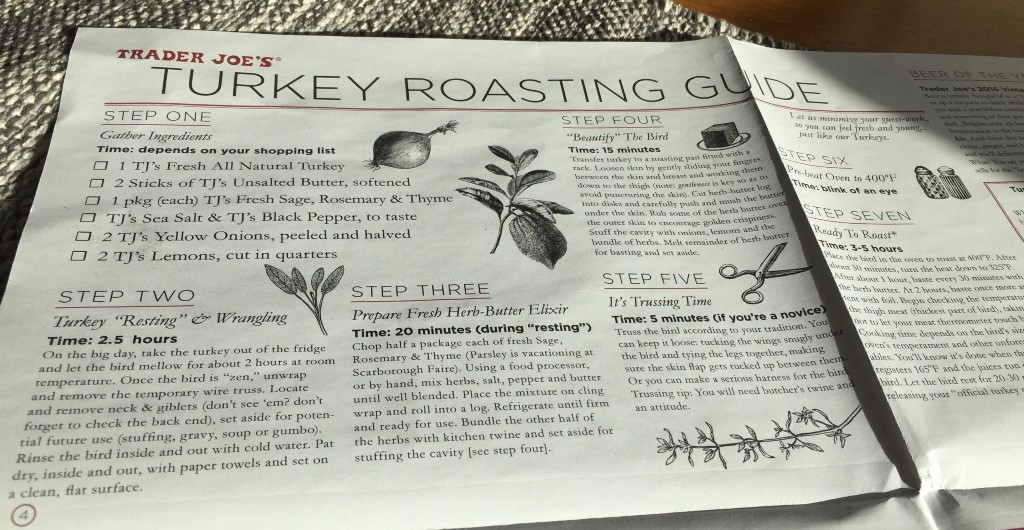
Cranberrying: a verb? Yea or nay? Two of the ways to “cranberry” are “Cranberries” and “Dried Cranberries,” and the other three are cranberry sauces, so how does that inform your answer?
The middle of the broadsheet is a lot of boring potato and vegetable stuff, kind of like the Thanskgiving sides are in real life. I will pause here however to point out the inconsistent use of “portabella” versus “portabello,” and the all together unforgivable phrase “Baby Bella Mushrooms.” The thing about the p*rt*b*ll*s is not even that I feel so deeply in my heart that there is one true correct spelling, given how many “o” sounds in Italian actually sound more like an “ah,” just that people continue to Samuel Johnson the word into tiny splinters. (Yes, I just used the dictionary man as a verb. Proper noun verbs are cool.)
Last but not least, the back page. Which is also the upside-down second and third page if you accidentally left it unfolded like I did. A two-column header announces “Another Take On Turkey & Potatoes,” the same way that every food-related publication must do, year in and year out. The first item in this section is abhorrently confusing and it took me three reads to realize it wasn’t a ginger-and-molasses-basted turkey. The Gingerbread Turkey Kit is an assemble-your-own cookie “tableau” that “stands out for its non-house-like qualities.” Okay so I get that it’s supposed to be a turkey in place of a Gingerbread House, but then what is the powdered-sugar icing for, besides perhaps those little white booties that look like tiny chef’s hats that no one has ever put on a turkey ever? It also comes with the traditional adornments: chocolate buttons, colorful fruit gums and nonpareils, so that you can put candy on a turkey which is again disgusting and does not mimic any kind of dressing or decoration traditionally done to turkeys at Thanksgiving (at least at my house).
Just when I think Trader Joe’s has gotten a little too carried away with dorkiness, they actually had a very good idea. Pecan Pie (Filling) In A Jar. This is rather a clever thing to sell and it probably looks disgusting, sort of like the jar of oatmeal and fruit fly larvae that made Ramona Quimby barf at age 8. Just add butter and eggs, dump it into a pie crust and you’re all set! It costs $6.99 which is frankly expensive but then again so are pecans I think so let’s just call it even. Thanks, Trader Joe’s!
Storytelling Won The Election
I am an idiot novelist and screenwriter and I know the dumb reason why Trump won.
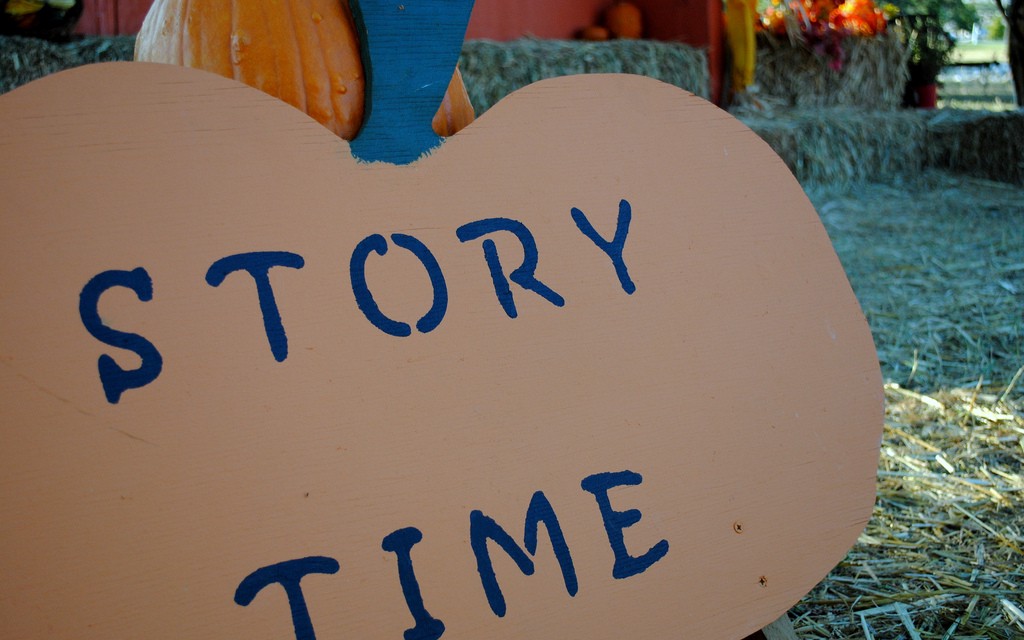
I tell stories for a living. I think a lot about how thunderingly stupid it is that this can be an actual job. Basically I type lies alone all day.
The lies are lies in a few ways. For one thing, they are the made-up actions of people who don’t exist. But for another, more important thing, they grossly simplify the feelings and actions and lives of those people. I have to fit an entire group of people, and the places in which they exist, and the infinitely subdivisible blocks of time they move through, into 300 pages or 100 minutes. So most of the bewildering complexity and contradiction and nuance of anything resembling real life gets lost. What’s left is a story.
That’s really all storytelling is. Life is way too complicated to make any kind of sense if you try to perceive all of it at once. Here is how you write a story: you take life, cut out pretty much all of it except for like four things, make up some other stuff, and then move all the stuff around, and just in general distort the world in all kinds of ways until it makes sense to our dumb primate brains.
Trump won and Clinton lost. And there are millions of reasons why that was the outcome, not just one reason. Millions and millions of reasons whose influences can’t even be quantified with respect to each other. Your friends and family are screaming all of them at each other on Facebook right now, and it’s a goddamn nightmare. But let’s get grossly simplistic, and let’s choose one reason, and let’s make a story out of it.
Here’s my dumb story: Trump told a story, and Clinton didn’t.
Like I’m doing right now, Trump told a grossly simplistic story in his campaign. If you’re reading this, you’re probably a pointy-headed blue-stater like me, and you’re probably repelled by that story’s worldview. But beyond that, you also probably feel contemptuous of it as a story. Because 1) it’s grossly simplistic, and 2) he made a bunch of stuff up.
But as a story, it was super effective. It was very easy to understand. You could remember all of it, and it was about America. It addressed the same audience every time, and it pointed to obvious solutions that the Democrats were not going to do. Immigrants are taking your jobs; I am going to kick them out! Muslims and black people want to kill us; I am going to stop them and jail them! Comfy city-dwellers on the coasts don’t believe or care that your jobs are gone or crappy; I hate those freaking people as much as you and will not allow them to run things anymore!
What was Clinton’s story? Clinton ran as a technocratic incrementalist, who knows tons of stuff about tons of stuff and will make well-considered technical improvements to our country here and there, continuing and sharpening our neoliberal trajectory with policies that address this thing and that thing, based on dizzying amounts of science and data. She’ll react to world events on a studied, case-by-case basis. That is both a very sound vision of a presidency, and the most boring thing I have ever typed. I had to get up two different times for coffee while writing it. It’s not a story at all.
You might say: She also ran as a glass-ceiling breaker, a highly experienced person, and basically the complete screaming opposite of Trump. Those are all just stories about her, though. They don’t tell a story about America that rebuts Trump’s.
Gore was a technocratic incrementalist. Kerry was a technocratic incrementalist. Remember when Bush mocked Kerry for coming up with “a new nuance”? Remember how infuriating that was? Did you not yell at your television or giant desktop computer, “NUANCE IS GOOD! YOU SMIRKING, IDIOT CHIMP!! NUANCE IS DETAIL, AND DETAIL IS EVERYTHING!!!” But to most people, it’s not.
Technocratic incrementalists are super appealing to those of us with liberal-arts educations who have taken those educations to heart, because liberal-arts educations are about steeping you in the ever-surprising, relativizing complexity of the real goddamn world, and the Hillary Clintons and John Kerrys and Al Gores of the world operate in deference to that complexity. And that’s why the Democratic party keeps nominating them. But technocratic incrementalism makes for terrible storytelling. And technocratic incrementalists make terrible campaigners. They might make good presidents, but they’re atrocious candidates.
This was why Bernie — and I know how much you don’t want me to bring him up, but sorry, I have to — was so electrifying. Bernie also told a story that was incredibly easy to understand: the wealthy are too wealthy, the middle class has gotten a raw deal, and it’s time to rein in capitalism at least somewhat. This was why there was such shocking overlap between supporters of Bernie and Trump, two candidates proposing wildly different policies. People give so, so much less of a shit about policy than most of us want to think. I can’t stress this enough. So much less of a shit. They just need a good story.
Trump knew all of this. Trump’s training is in reality television and conmanship. He’s wildly good at figuring out stories that lots and lots of people want to hear. And one reason he’s great at this is: He never ties himself up into knots trying to concoct a story that everyone wants to hear. A conman doesn’t try to con everyone in the room. He knows he can’t, and he doesn’t need to.
So Trump didn’t try to meet everyone where they live, or tailor his thing to what every single person wants to hear. That is a Democratic tendency, and politically speaking, it is insane. It makes you a mealy-mouthed fence-sitter whose pronunciations are compromised to the point of inanity. America is good! Except, don’t worry, people who are struggling, we know it’s also not good! Except, don’t worry, people who are doing great, we know we’re doing great! But we know we also have a lot of work to do! But obviously we’re going to stay the course and everything! But for sure we also need to change a ton of stuff!
So here’s my plea. Let’s not mistrust the big story the next time around. Let’s not make it a disqualifying thing to have a simple vision, one that excites some people and turns other people off. And I know this plea might be pretty dispiriting. It sounds like I’m asking you to let politics be dumber. But let’s not pretend we’re smarter than we are. We’re all idiot chimps who need stories to make sense of the world. That’s why my stupid job exists. We’re moron chimps who are still just learning the basics of abstract thought.
And if we tell ourselves we aren’t, we’re just telling ourselves a story that isn’t very good.

P.S. I know this story doesn’t contain enough contempt for Trump or his supporters for your taste. Here you go: Trump is a magic unwipeable anus. He is a fecally encrusted anus who uses magic to prevent itself from ever being wiped. And his supporters voted for him. But we have to share a country with them. The more contempt you have for them, the more they’ll have for you. I’d like to ask you to try not to assume the worst in people—just for pragmatic reasons, just because that makes it so much harder to heal. But that’s almost offensively easy for a straight cis white guy to say.
We’re stuck with a magic unwipeable anus in the White House for the next four years because its shitty mouth told a hell of a story. Next election, let’s find someone who tells a better one.
Jesse Andrews is a novelist and screenwriter. He is the author of the New York Times bestsellers Me and Earl and the Dying Girl and The Haters, and the screenwriter of Me and Earl’s Sundance Grand Jury Prize–winning feature film adaptation.
Java Street, Brooklyn

Illustration: Forsyth Harmon
There are two versions of you, now that we’re in this awful before-and-after. And now, in the after, the fact of you as an African-American woman worker within a group of white male construction workers has this whole other tenor. In the before, it just seemed kind of glorious and awesome. In the after, it’s something different: more fraught and vulnerable and painful, in the way that everything now seems more fraught and vulnerable and painful now that we can no longer be only half-awake to hate. In the before, though, you just made me laugh in a way that hardly ever happens with friends let alone strangers: it was that kind of laugh that just ambushes you and overtakes you.
When I got to my bike I saw that constructions workers had tied one end of the tape cordoning off the area to my handlebars. I stood there, taking in this minor stupidity for a moment, and then put my bag down and began trying to unknot it. I could sense the group of them working in the road looking at me, standing in their hole, holding their tools, paused and I kept fumbling with this ridiculous knot — self-conscious, irritated and amused.
“Who did that!” a voice shouted with a kind of expansive weariness, and I looked around and there you were, a black woman, striding towards me in your high-vis vest and hardhat, while the group of guys just stood there. “Knuckleheads!” you said, with emphasis, as you cut the tape. The way you said that word — the affection and exasperation and zeal in it — was so amazing that I wanted you to say it again. And you did: “What a bunch of knuckleheads.” I thanked you for freeing my bike but really I was thanking you for a few things. For making me laugh, and for going to work every day, for putting up with all the bullshit that entailed. In that moment, you were literally a black woman clearing up the mess of a group of dumb white men.
What's Your "Baggage?"
I love “Chelsea”

Are you familiar with Jerry Springer’s short-lived dating show “Baggage?” Three hot local singles would reveal secrets about themselves to a contestant looking for love in ascending intensity. It was sort of like “The Dating Game,” but everyone was talking about their fetishes, overbearing parents, and immense amounts of debt. Their first secret, their “small baggage,” would be in a little briefcase; “medium baggage” was a carry-on bag; and “big baggage” was a rolling suitcase they saved for the end of the episode. My name is Christine, and my medium baggage is that I’ve watched every available episode of Chelsea Handler’s Netflix show, “Chelsea.”
I’ve been quietly tuning in every week since the debut in May, and during that time I’ve also shyly come out to certain friends as a fan of what she’s doing. But as someone who generally considers herself not-an-idiot, this has been a complex preference for me to accept. In the early-aughts, Handler’s booze-fueled, sex-positive comedy was a sort of female answer to Tucker Max. She discussed race… insensitively. She had a shorter man named Chuy as her sidekick and almost exclusively referred to him as “a nugget.” It was as if someone was asking her to hinge a career on the question, “What if frat comedy, but pink?” And while she still “raps” on Snapchat, and sometimes reveals that her point-of-view is a little less informed than you’d expect from a TV host, she’s currently operating the entire talkshow with the mission of educating herself personally, and it’s brave as fuck.
The show is only a few months old, but one cause that’s been close to her heart through the entire run is insisting her viewers not vote for Donald Trump. She helmed a voter registration campaign, spoke openly about her own concerns, and made time to incorporate a diverse spread of experts into the show’s otherwise “reasons I love Xanax” and “I’m never having children”-style segments. This week, in the first episode after Trump’s election, she had California Senator Barbara Boxer on to try and make sense of things.
Here’s what I love about the clip: It is cool to care. It is cool to have skin in the game. It is cool to fuck up and feel embarrassed and stand back up and try again. It takes more than balls, it takes a respect for what lies outside of yourself—a fundamental acceptance that you are not now or ever going to be perfect, but that it is your responsibility to try in this world. There is no ego in Chelsea Handler asking these questions as far as I can tell, just a hope to connect with people and understand them in a changing social climate, which, same. For all of us. Same.
People also take for granted how special it is when someone can be comfortable being unknowing. We all have our ignorances and our blind spots, but not everyone has an easy time saying, “I am ignorant, I do not know everything, and I am here to learn.” It’s something that Handler has no problem with, and I’d argue it’s her greatest gift.
“I didn’t graduate high school!” she often laughs to her guests. “Explain this to me!” And then they do. Things like the electoral college, climate change, civil rights. She asks and she learns, and in watching her do that, I’m learning too. I’m learning what it looks like to take your work seriously and keep fucking going.
Anyway, watching Chelsea Handler cry with Barbara Boxer while asking where we go from here was a comfort to me this week. Watching Barbara Boxer know—like really know—that this is an opportunity for people to double down and continue advocating for their causes was a comfort. And I’m thankful for it.
The Ballgame
The Adventures of Liana Finck

Liana Finck’s work appears regularly in The New Yorker. Her graphic novel is called A Bintel Brief. She is on Instagram at @lianafinck.

